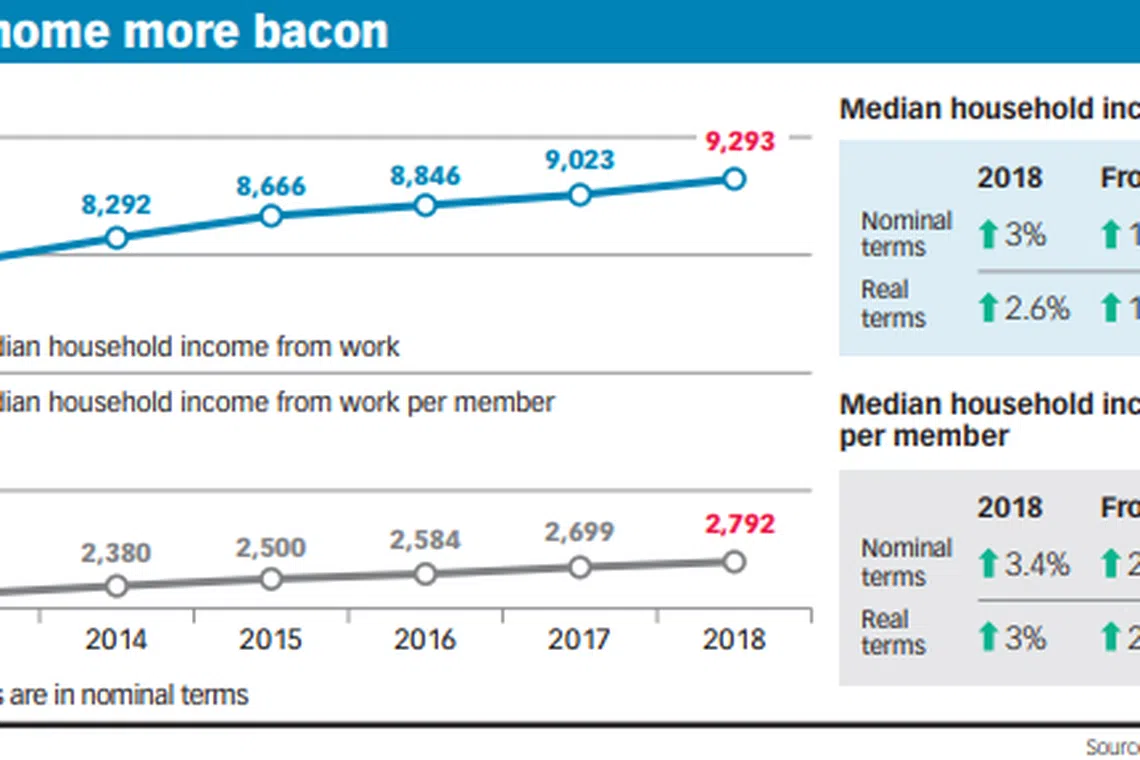Growth in Singapore household per capita income slows in 2018
Median household income up 2.6% in real terms, says Department of Statistics

Singapore
GROWTH in household income per head slowed last year, despite a shrinking number of people under each roof.
And, despite what Maybank Kim Eng senior economist Chua Hak Bin called a "respectable increase", income growth could turn sluggish amid a broader slowdown this year, analysts told The Business Times.
Median household income was up by 2.6 per cent in real terms to S$9,293 a month, said the Department of Statistics on Wednesday.
Income for each household member saw 3 per cent real growth, to S$2,792, lower than the previous year's 3.9 per cent increase, and is the smallest annual change since 2012.
And this is after the effects of inflation were stripped from wages. Consumer prices rose by 0.4 per cent last year, or 1.7 per cent when housing and private transport costs were excluded.
The mean or average real growth in monthly income was 0.5 per cent for households overall, down from 3.2 per cent in 2017; it was 3 per cent on a per-capita basis, compared with 3.4 per cent the year before.
Aurobindo Ghosh, assistant professor of finance at the Singapore Management University, was cautiously optimistic about prospects for 2019.
He noted that households might need to earn about 4 per cent more in dollar terms to achieve the same level of real improvement, as inflation is expected to pick up this year.
But even if inflationary pressures recede, income growth could still continue to ease on an economic downturn, said Maybank's Dr Chua.

Prof Ghosh remarked that "consumption might grow at a more deliberate pace" in a slowdown, and added that last year's slower income growth may also reflect wage stabilisation in a slightly slacker labour market.
Singapore's labour force participation rate held steady at 67.7 per cent in mid-2018, after peaking at 68.3 per cent in 2015, going by the most recent Manpower Ministry figures.
Even though households saw growth across all income brackets last year, the rise was not evenly felt.
Average income per household member rose by 2.7 per cent in the bottom 10th of all homes and by 2.3 per cent in the top 10th; the strongest growth - 4 per cent - was in the 71st to 90th percentiles, or the top 11 per cent to 30 per cent of earners.
The Gini coefficient, which measures income inequality, dipped from 0.459 in 2017 to 0.458 last year. Zero represents total income equality and one represents total inequality.
With government transfers and taxes factored in, the Gini coefficient was down to 0.404 - even as the average handout from public schemes slipped by a smidgen, to S$4,494 per household member, on a drop in MediShield Life transitional subsidies and the absence of one-off grants.
While Prof Ghosh noted that there has been "a stable or slightly declining trend in inequality in Singapore", Dr Chua emphasised that the government still has the fiscal leeway to bump up transfers to households in next Monday's Budget statement.
Meanwhile, households here are getting smaller. They had 3.24 people each on average last year, down from 3.5 in 2008, and each had an average of 1.68 workers. This means more money per head for now, but as Dr Chua noted: "A shrinking household might artificially push up the average, but that's not such a good thing in the long term."
In fact, the ageing population has driven up the share of households where no one works. These made up 12.1 per cent of homes here last year, against 8.6 per cent in 2008.
Household income from work includes Central Provident Fund contribution from employers, but not other sources, such as dividends or rent.
Copyright SPH Media. All rights reserved.
